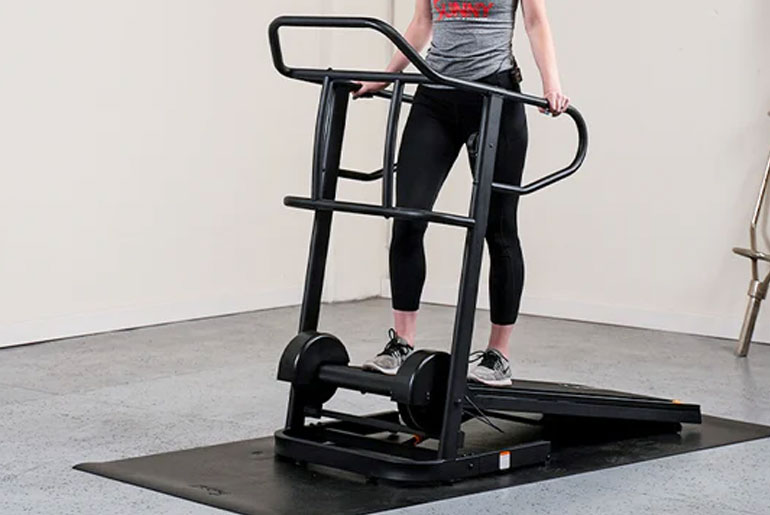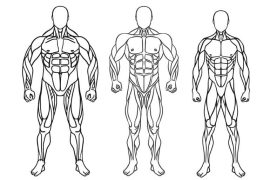As a certified personal trainer and strength and conditioning specialist, I advocate for a balanced approach to weight loss using the treadmill. I have found that incorporating a mix of low, medium, and high-intensity treadmill workout can be effective, considering the individual’s fitness level and recovery capacity.
My top pick for a weight loss treadmill workout is a 30-minute session that combines bodyweight resistance training movements with walking at a moderate to brisk pace. This approach offers a comprehensive metabolic boost without the extreme strain associated with high-intensity cardio. It aligns with the understanding that slower, steady-state cardio, including walking, can be equally effective for weight loss while being easier to recover from and allowing for more frequent sessions.
This approach considers the importance of improving cardiometabolic health and acknowledges that not everyone needs to opt for super-intense cardio to achieve weight loss goals. By incorporating a variety of treadmill workout, clients can enjoy the benefits of improved strength, cardiovascular health, and weight loss without the potential drawbacks of excessive intensity.
The recommended 30-minute treadmill workout combining bodyweight resistance training with walking represents a balanced and effective strategy for weight loss, promoting overall health and sustainability.
30-Minute Treadmill Bodyweight Circuit:
The 30-Minute Treadmill Bodyweight Circuit for Weight Loss is an excellent overall workout that combines cardiovascular exercise with bodyweight resistance training. This approach has been supported by research, indicating that the combination of resistance training and cardio is more effective for reducing body mass index, waist circumference, and body fat percentage than cardio alone.
How to Make It Easier:
- Reduce the walking speed as needed. Starting with 2 mph is recommended, allowing for a gradual progression.
- Modify traditional floor pushups by doing them against a wall. This modification helps individuals who find standard pushups too challenging.
- Take breaks as needed during bodyweight exercises to ensure proper form and prevent excessive fatigue.
How to Make It Harder:
- Increase the treadmill speed to a jogging or running pace (5 to 7 mph) based on individual abilities. This intensifies the cardiovascular aspect of the workout.
- Aim to perform pushups and lunges continuously without breaks. This challenges endurance and muscular stamina.
- For non-walking or running exercises, stop the treadmill and perform them on the floor or on an exercise mat using bodyweight. This adds intensity and variety to the routine.
Description:
- Combines resistance training with cardio for a metabolism-boosting effect.
Pros:
- Builds strength, efficient two-in-one workout.
Cons:
- May be challenging to implement at the gym, requires starting and stopping the machine.
4 x 10-Minute Treadmill Work out for Weight Loss:
The 4 x 10-Minute Treadmill Workout for Weight Loss is designed to accommodate busy schedules by breaking down the workout into shorter, more manageable sessions. This approach is supported by research that indicates several short walks throughout the day, especially after meals, can offer significant benefits for blood sugar control and weight loss.
How to Make It Easier:
- Set the treadmill to a comfortable speed, ideally between 3 and 4 mph.
- After breakfast, lunch, and dinner, walk briskly for 10 minutes each session.
- Consider adding an extra session before bed or after an evening snack to maximize the benefits.
- Adjust the treadmill speed to your fitness level, and take breaks as needed.
How to Make It Harder:
- Warm up for about 5 minutes before starting the workout.
- Complete 4 intervals of 10-minute runs at a moderate to comfortably-hard intensity.
- Walk for a few minutes to cool down after the intervals.
- For an extended 45-minute workout, split the intervals into two separate sessions (morning and evening) by warming up instead of doing two intervals consecutively.
Description:
- Short walking sessions multiple times a day, especially after meals.
Pros:
- Easy to fit into your day, improves digestion and blood sugar.
Cons:
- Not convenient for the gym, may not be enough activity for some people.
60-Minute Walk-Run Treadmill Work out for Weight Loss:
The walking combined with periods of moderately paced running in the aerobic cardio zone provides an effective workout for building aerobic fitness and burning calories for weight loss. This approach offers a more accessible alternative to high-impact, high-skill activities like continuous running, making it suitable for individuals with varying fitness levels.
Benefits of the Workout:
- Builds aerobic fitness.
- Burns calories for weight loss.
- Incorporates walking for lower-impact exercise.
- Improves sleep, moods, and helps manage stress levels.
Consideration for Running:
- Running is a high-impact, high-skill activity.
- Requires an intermediate to advanced fitness level to build endurance.
Importance of Slower Cardio:
- Slower cardio improves sleep, moods, and stress levels.
- Vital during weight loss, which can be stressful on the mind and body.
Calorie Burn and Effort:
- Total calorie burn for a workout session is crucial for weight loss.
- Research suggests that effort matters, but longer, slower-paced workouts can yield similar calorie burns.
How to Make It Easier:
- Add more walking intervals.
- Slow down the pace of your runs as needed.
- Modify the workout to suit your fitness level and comfort.
How to Make It Harder:
- Run for longer periods, aiming for 10-minute bursts.
- Increase the incline for your runs to add intensity.
- Shorten walking intervals to 2 minutes for a more challenging workout.
Description:
- Beginner-friendly walk-runs for longer, less intense exercise.
Pros:
- Helps reduce stress, balance moods, and improve sleep quality.
Cons:
- May be too long for busy people, may not be motivating for some people.
45-Minute Weighted Vest Treadmill Workout for Weight Loss:
The Weighted Vest Treadmill Workout for Weight Loss involves strapping on a weighted vest to increase the intensity of your workout, leading to higher calorie burn without altering your speed, incline, or workout duration. This method has been supported by research, indicating benefits such as increased oxygen uptake, heart rate, carbohydrate oxidation, and energy expenditure without changing your natural stride, thereby minimizing the risk of injury.
Increased Caloric Burn:
- Wearing a weighted vest increases energy expenditure without changing speed, incline, or workout duration.
- Higher calorie burn contributes to weight loss.
Safety and Reduced Injury Risk:
- Research suggests that a weighted vest doesn’t alter the length or frequency of your stride, reducing the risk of injury.
- This makes it a safer option for those looking to intensify their workouts.
Preservation of Muscle Mass:
- Wearing a weighted vest during weight loss may help prevent the common side effect of losing muscle, according to one study.
Choosing the Right Weight:
- Opt for a 10- to 20-pound weighted vest for this workout.
- Adjust the weight based on your strength and comfort level.
How to Make It Easier:
- Start with a lighter weighted vest and gradually increase the weight as you become stronger and more comfortable.
- Adjust your speed or shorten the workout duration if needed.
How to Make It Harder:
- Jog or run for longer durations or at higher speeds.
- Reduce walking breaks or eliminate them altogether.
- Increase the incline during brisk walks or running intervals for added intensity.
Description:
- Wearing a weighted vest for increased calorie burn without changing gait.
Pros:
- Easily burns more calories, doesn’t change walking or running mechanics.
Cons:
- Requires access to a weighted vest, may not be comfortable for some.
30-Minute Incline Walking Workout for Weight Loss:
The 30-Minute Incline Walking Workout for Weight Loss is designed to enhance calorie burn by incorporating incline walking, engaging lower body muscles and promoting stability and joint mobility. The workout is adaptable to different fitness levels and can be adjusted to either make it easier or more challenging.
Caloric Burn and Muscle Engagement:
- Walking on an incline burns more calories than walking on a flat surface at the same speed.
- Engages lower body muscles including quadriceps, calves, glutes, hamstrings, ankle, knee, and hip flexors.
Stability and Joint Mobility:
- Incline walking improves stability and joint mobility.
- Caution is advised for those with balance issues, particularly at higher inclines.
How to Make It Easier:
- Reduce the incline to a level that feels comfortable and manageable.
- Adjust the walking speed to a pace that suits your fitness level.
- Shorten the length of the workout if needed.
How to Make It Harder:
- Increase the incline to 12 percent during minutes 5 to 10 for added intensity.
- Lower the incline at minutes 20 to 25 to initiate a gradual cool down.
- Alternatively, increase the walking speed, or try jogging or running throughout the workout.
Description:
- Walking on an incline for enhanced calorie burn and joint-friendly exercise.
Pros:
- Burns more calories than flat walking, easy on the joints.
Cons:
- Not all treadmills have an incline function, risk of falling for those with balance issues.
20-Minute High-Intensity Intervals for Weight Loss:
The 20-Minute High-Intensity Intervals for Weight Loss is a time-efficient workout backed by research for its effectiveness in burning calories and improving the cardiorespiratory system. However, it’s crucial to be mindful of the intensity and frequency due to the taxing nature of high-intensity interval training (HIIT) on the body.
Efficiency of HIIT:
- Research supports that HIIT is an efficient way to burn calories in a shorter time frame.
- HIIT can improve the cardiorespiratory system more effectively than moderate-intensity training, particularly in individuals with obesity.
Caution on Recovery:
- HIIT is taxing on the body and takes longer to recover from.
- Less ideal for weight loss phases when nutrient availability may be limited.
Frequency Recommendation:
- It’s advisable to limit HIIT sessions to a maximum of two to three per week.
- Include rest days in between to allow for adequate recovery.
How to Make It Easier:
- Decrease the speed during high-intensity intervals.
- Increase the rest periods between intervals.
- Beginners can start with brisk walking and light jogging instead of running.
How to Make It Harder:
- For advanced individuals, consider increasing the duration of high-intensity intervals.
- Ensure that any modifications align with individual fitness levels and do not compromise safety.
Description:
- High-intensity intervals for efficient calorie burn and improved fitness.
Pros:
- Improves cardiorespiratory fitness, quick and efficient.
Cons:
- Can be challenging for some fitness levels, may be difficult to recover from.
Treadmill Sprint Workout:
The Sprint Workout for Weight Loss is a highly efficient and time-effective exercise based on research showing that short sprint intervals can be potent for fat loss, especially targeting belly fat. This workout emphasizes anaerobic fitness and peak running speed, making it an excellent choice for those short on time. However, it’s essential to approach this high-intensity workout with caution and adhere to recommended frequency guidelines.
Efficiency of Sprinting:
- Research supports sprinting as a potent fat-blasting activity.
- Builds anaerobic fitness and peak running speed.
- Short sprint intervals are considered more time efficient than traditional HIIT for weight loss.
Frequency Recommendation:
- While highly efficient, it’s not ideal to engage in such intense exercise more than one to two times per week.
- This workout maximizes efficiency but requires careful consideration of recovery.
How to Make It Easier:
- Reduce the speed of the sprints.
- Perform fewer sprints overall.
- Adjust the workout to align with individual fitness levels and comfort.
How to Make It Harder:
- This workout is already a maximal-effort activity.
- For very fit individuals, consider reducing the rest period between sprints to 2 minutes instead of 4.
Description:
- Short, intense sprints for time-efficient fat burning and muscle building.
Pros:
- Super-efficient and effective, helps burn fat and increase muscle.
Cons:
- Very challenging, should not be performed too often to avoid overtaxing the body.
Choose the workout that fits your preferences, fitness level, and schedule. Always consider consulting with a fitness professional or healthcare provider before starting a new exercise routine, especially if you have any health concerns.
Quick Tips for Weight Loss Success:
- Combine Exercise with a Nutritious Diet: Exercise in conjunction with a healthy diet and proper calorie intake enhances weight loss efforts.
- Cardio and Resistance Training: Use the treadmill for cardio workouts and complement them with resistance training three to five days per week.
- Balance High-Intensity and Steady-State Cardio: While high-intensity cardio is effective, mix in slower, steady-state cardio like walking for better recovery and frequency.
Safety Tips:
- Thorough Warm-Up: Prioritize a proper warm-up, including a few minutes of walking at a slower pace.
- Appropriate Attire: Wear well-fitting workout clothes and supportive shoes to prevent strain or injuries.
- Stay Hydrated and Well-Fueled: Keep hydrated with water throughout your workout and ensure you’re well-fueled with high-fiber carbohydrates, especially for intense workouts.
- Gradual Progression: Start at a lower speed and incline, gradually increasing to avoid pushing past your current fitness levels.
- Listen to Your Body: Never push past pain and take rest days when needed. Pay attention to your body’s signals.
- Safety Features: Use the safety clip or key with the treadmill, especially if you’re a beginner. Ensure the treadmill is in good working order.
- Know Your Limits: Stop immediately if you experience dizziness, lightheadedness, pain, or if something feels off during the workout.
These tips emphasize the importance of a balanced approach to exercise, proper preparation, and paying attention to your body’s signals for a safe and effective treadmill workout. Always consult with a healthcare professional or fitness expert before starting a new exercise program.
Disclaimer:
The information contained in this article is for educational and informational purposes only and is not intended as a health advice. We would ask you to consult a qualified professional or medical expert to gain additional knowledge before you choose to consume any product or perform any exercise.








